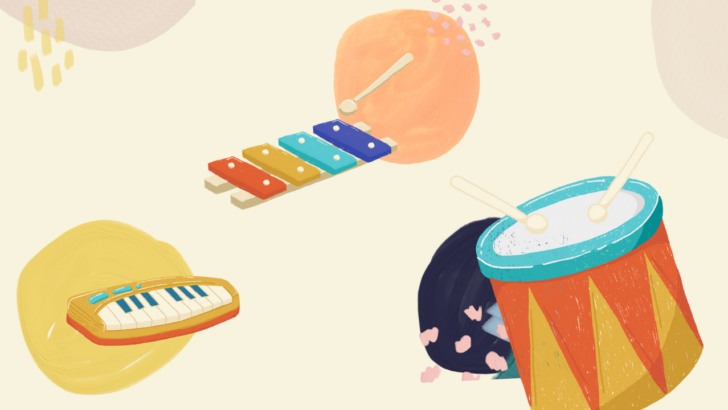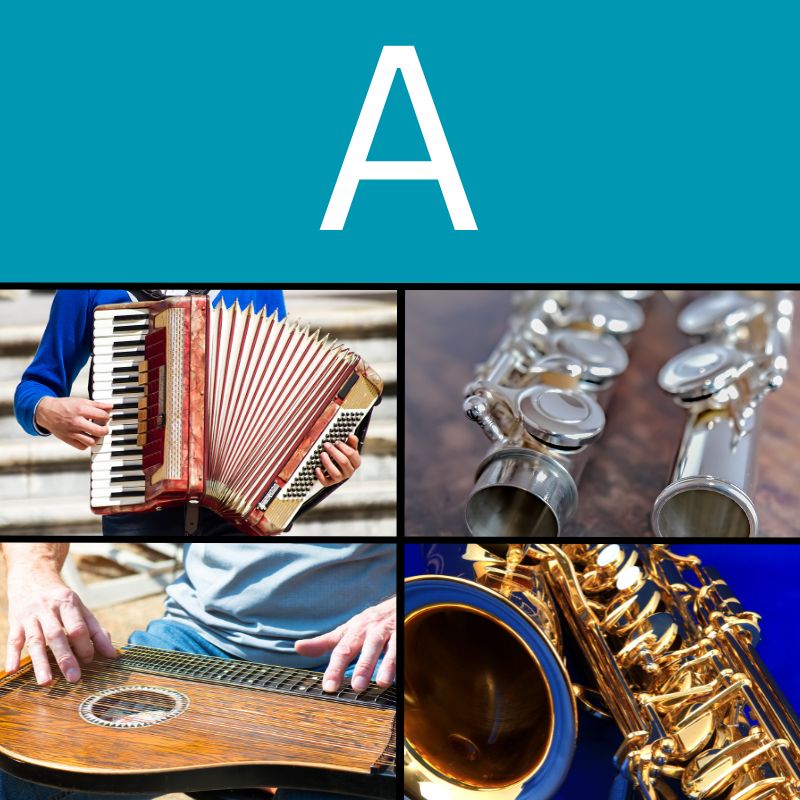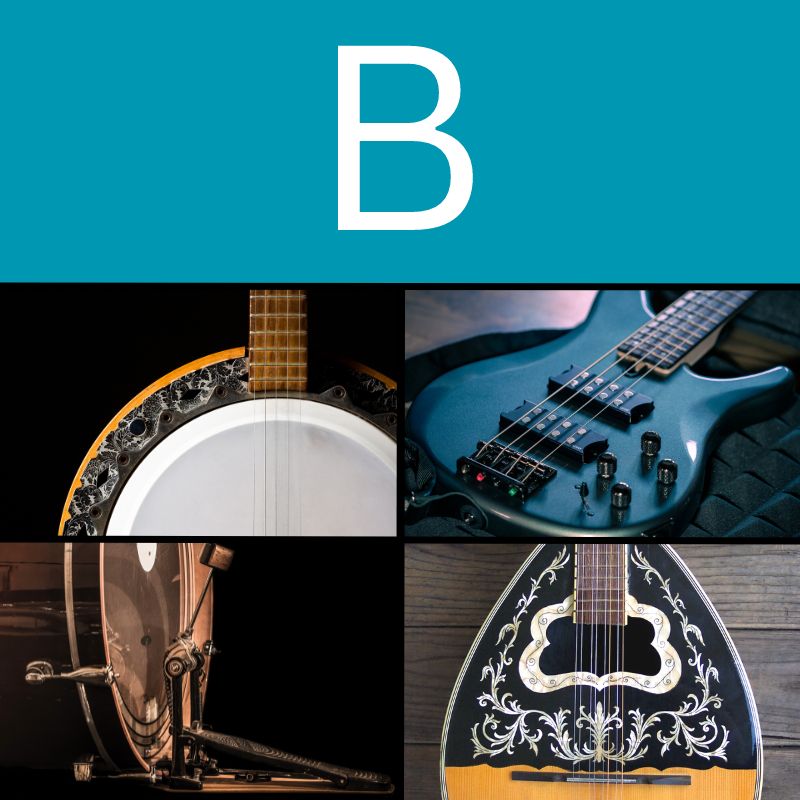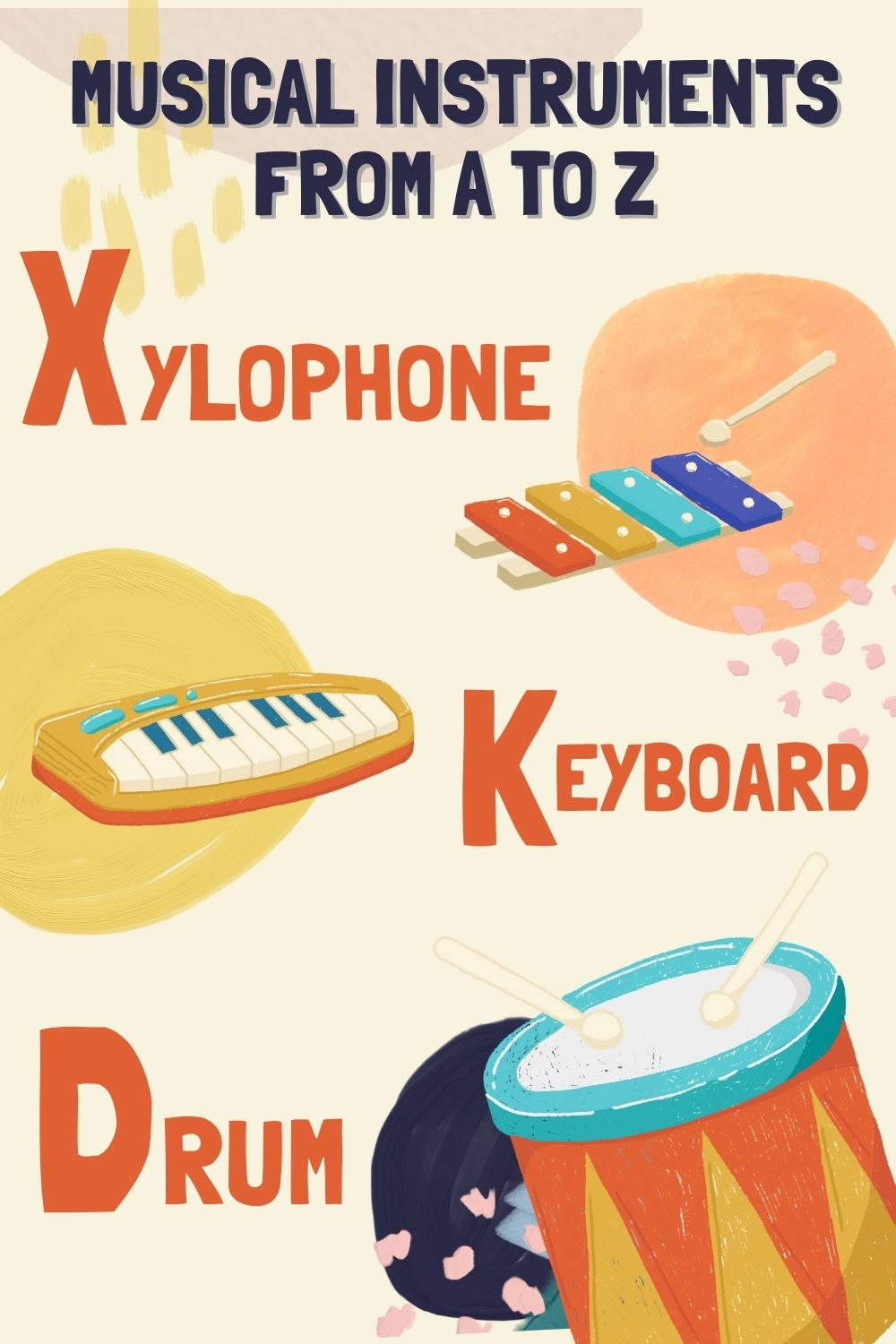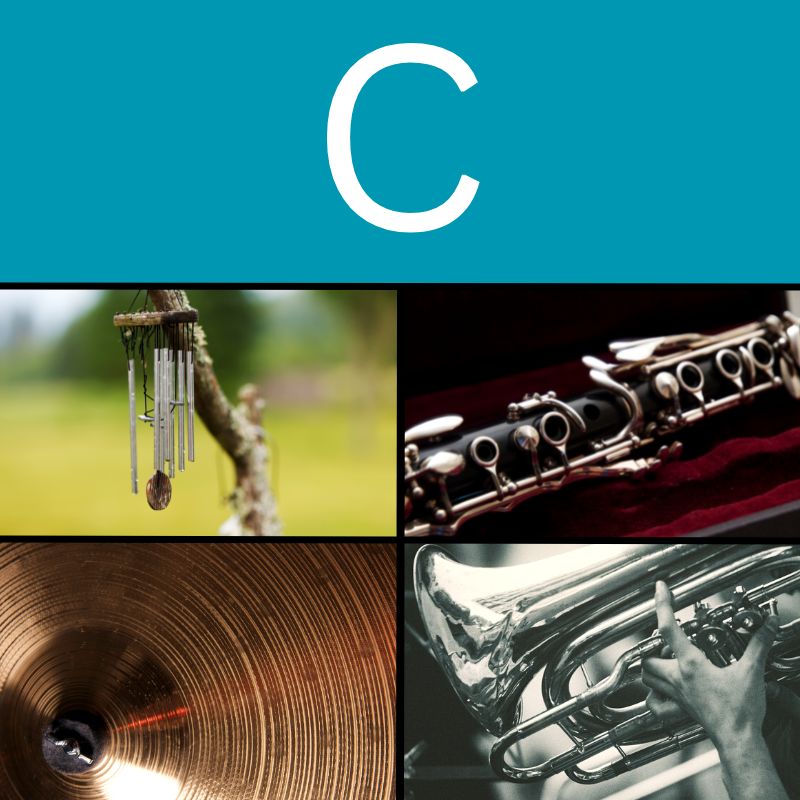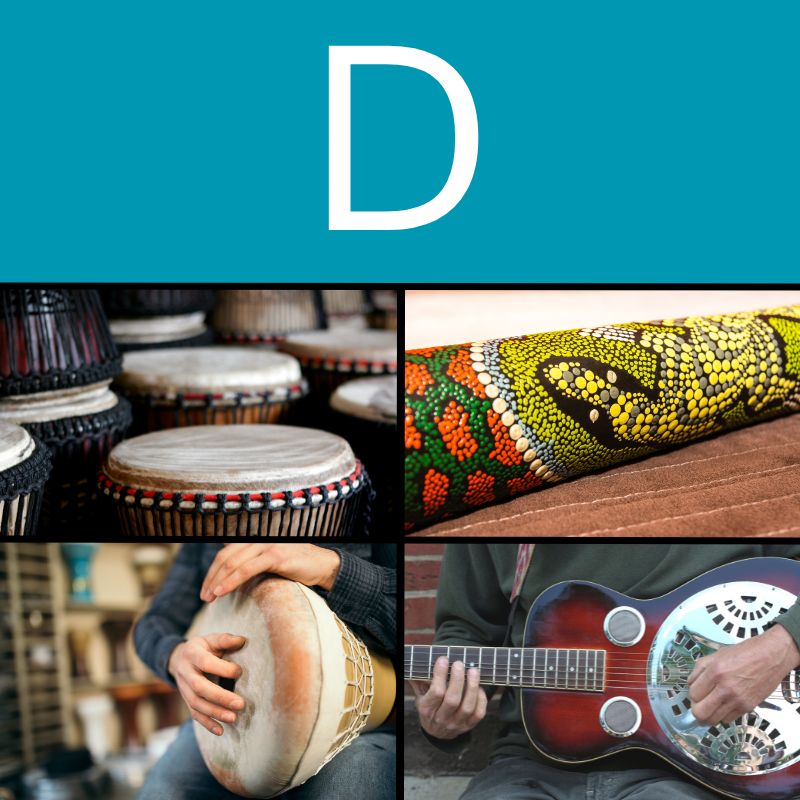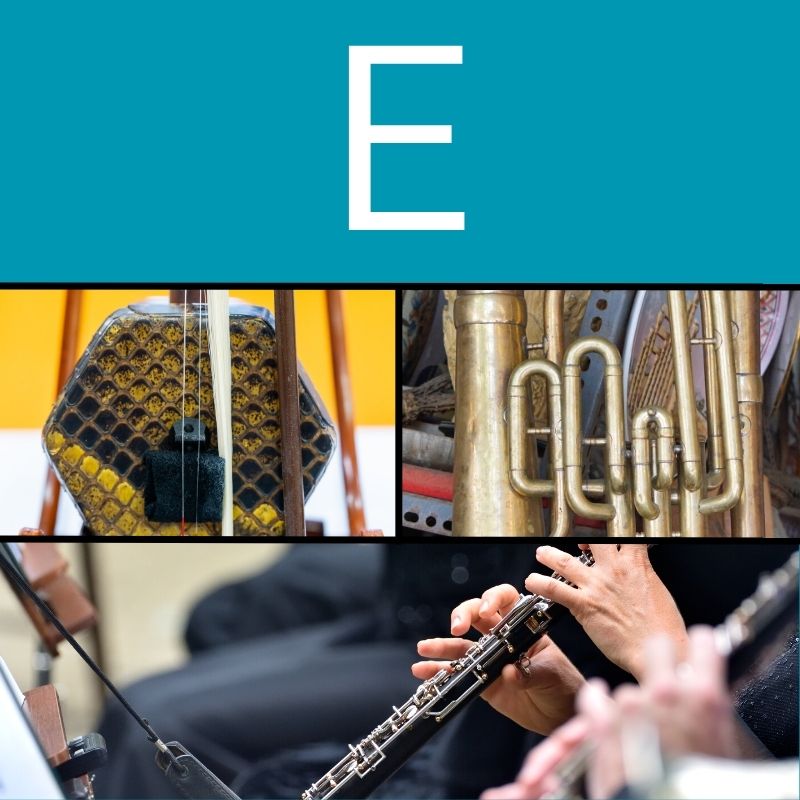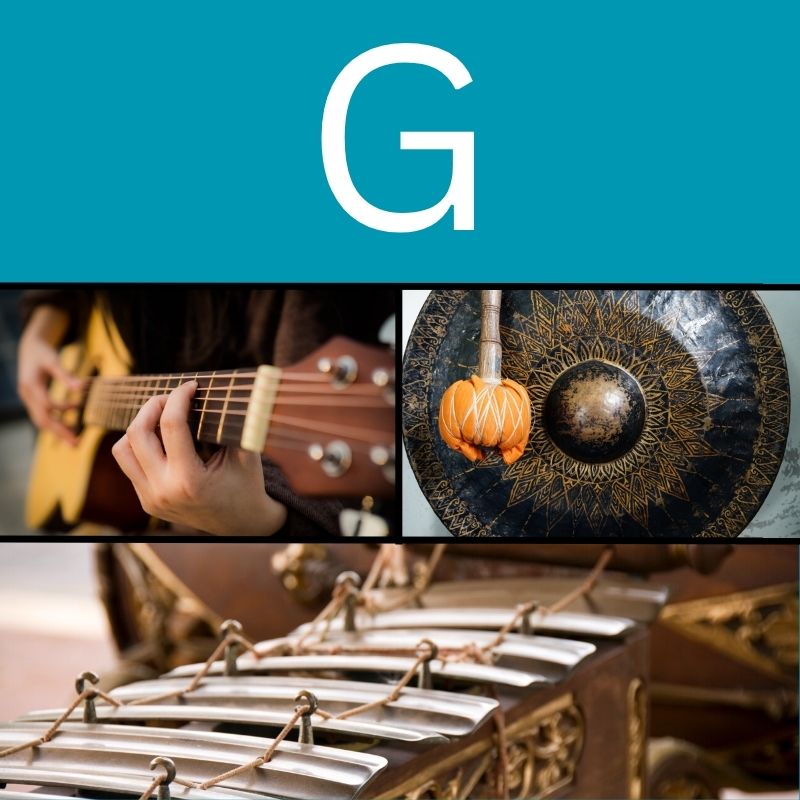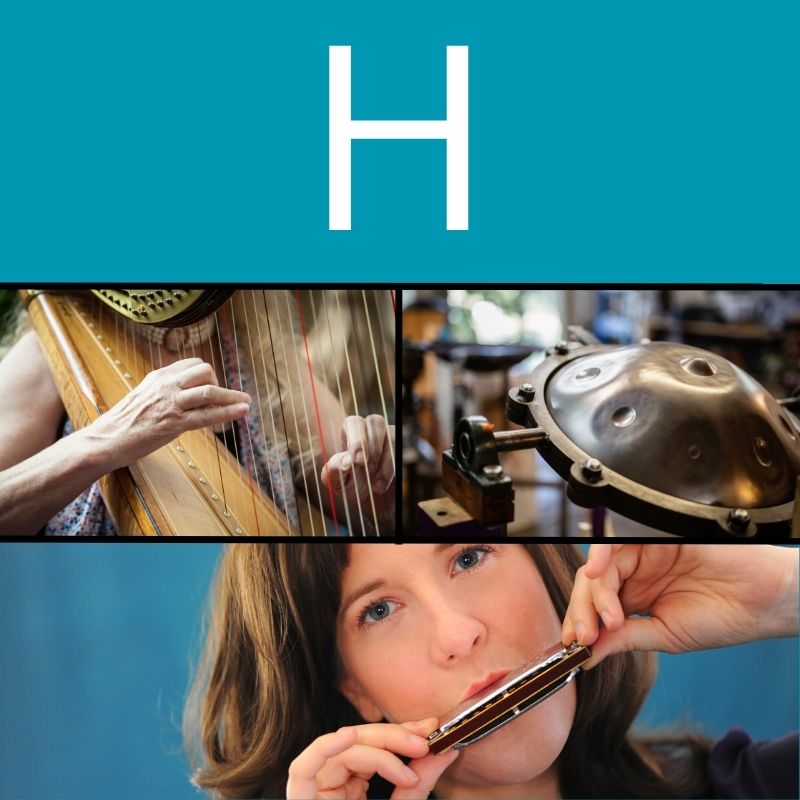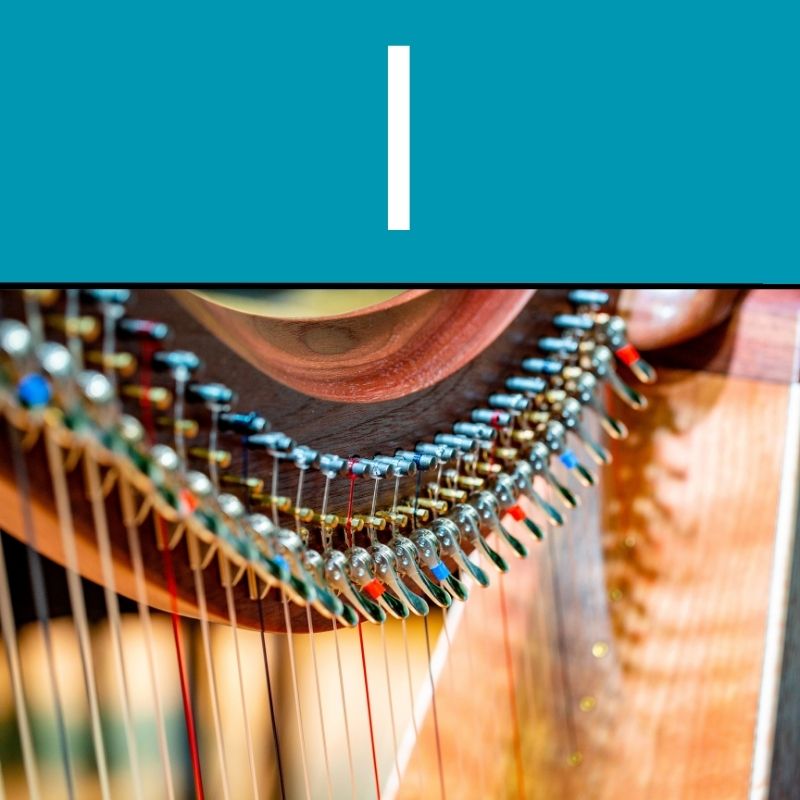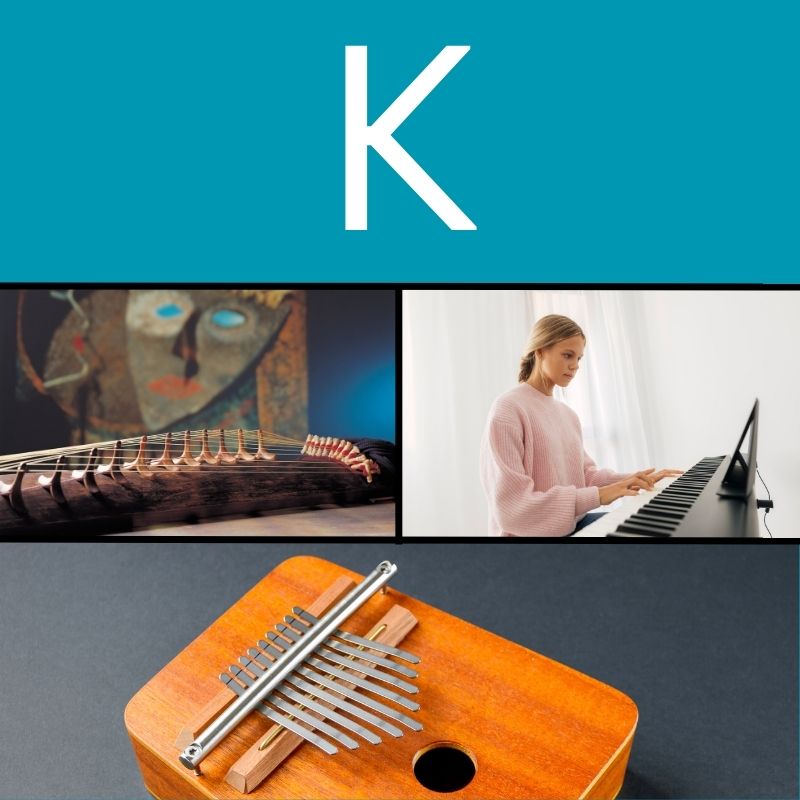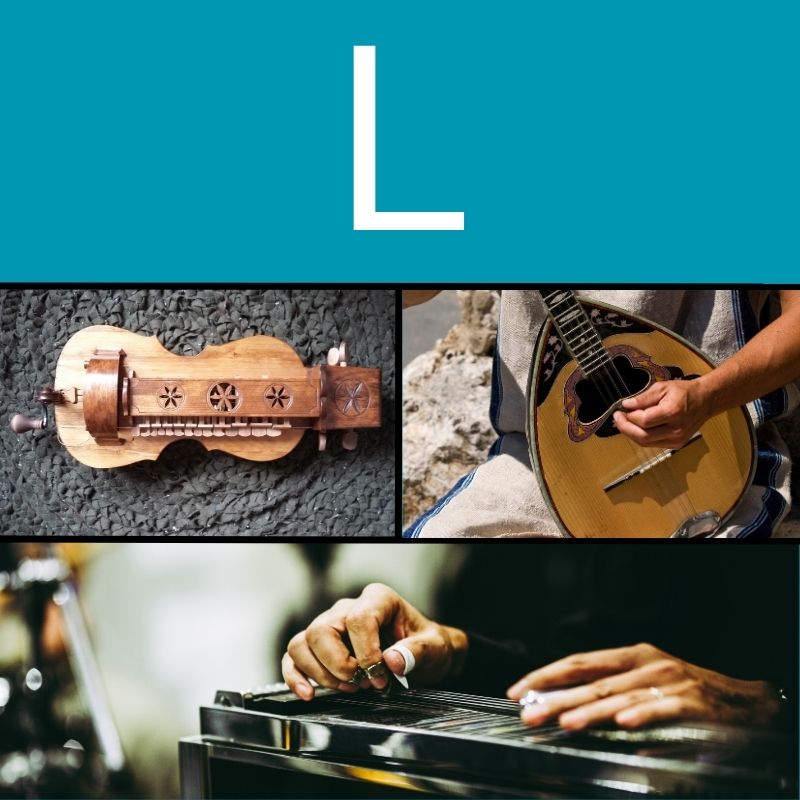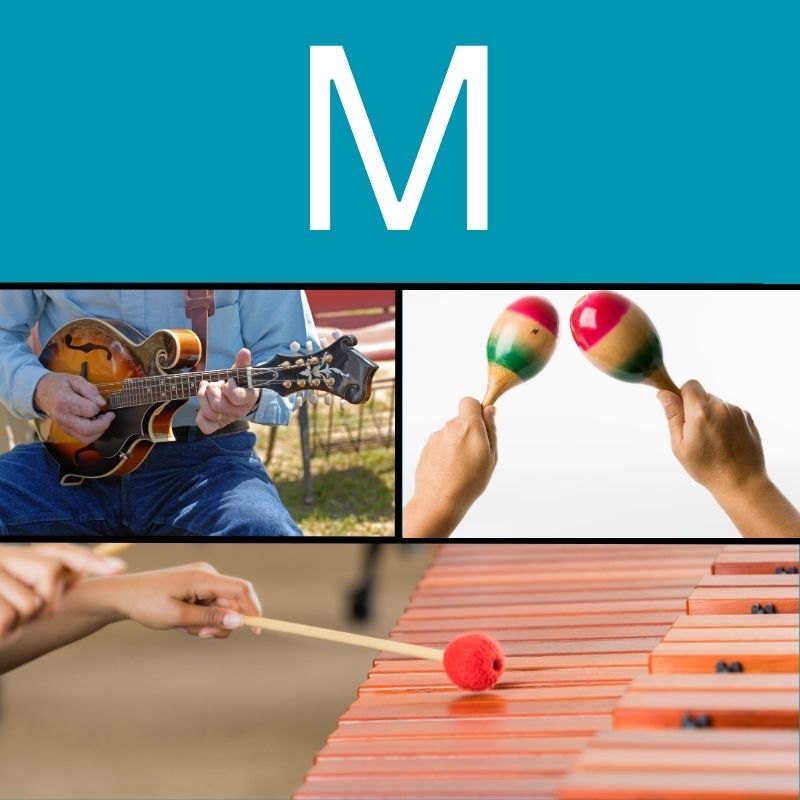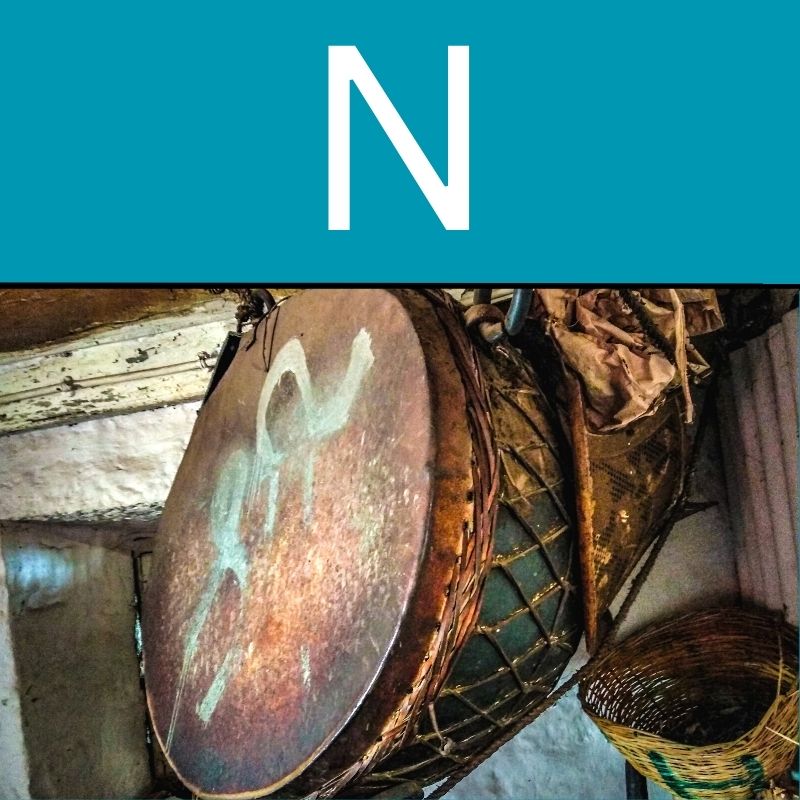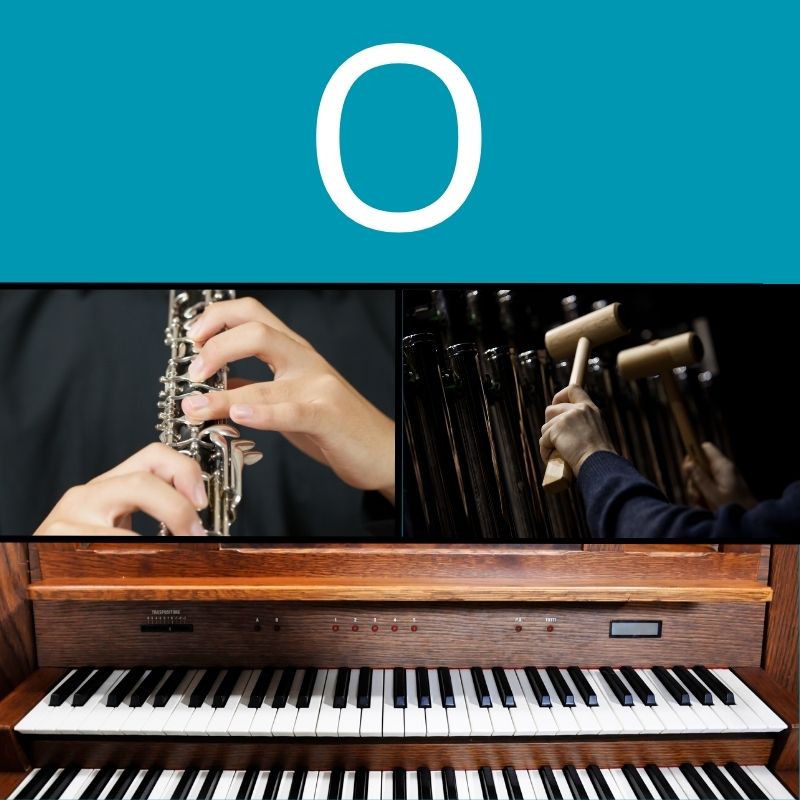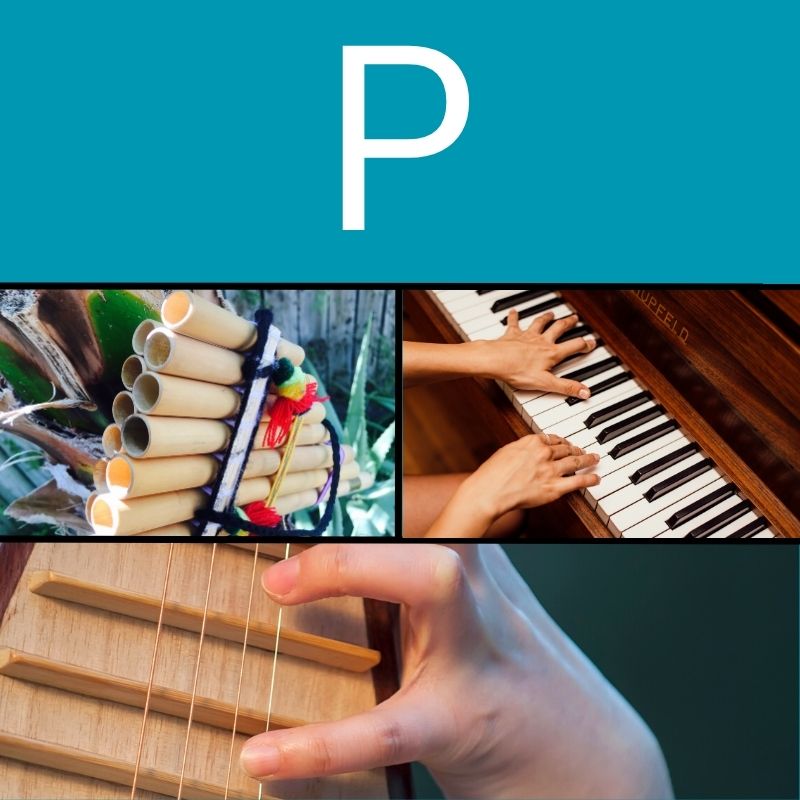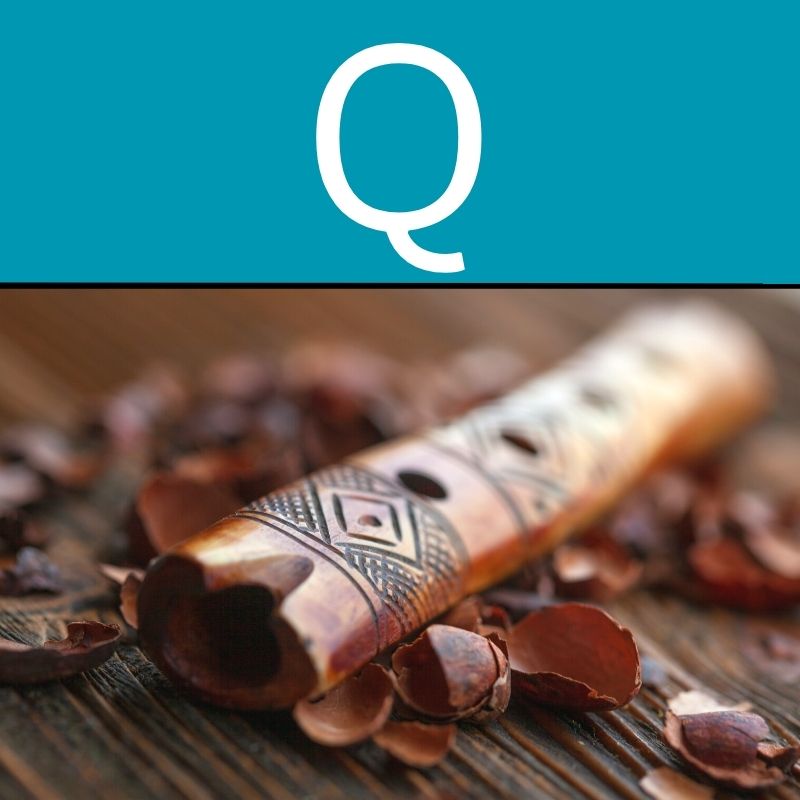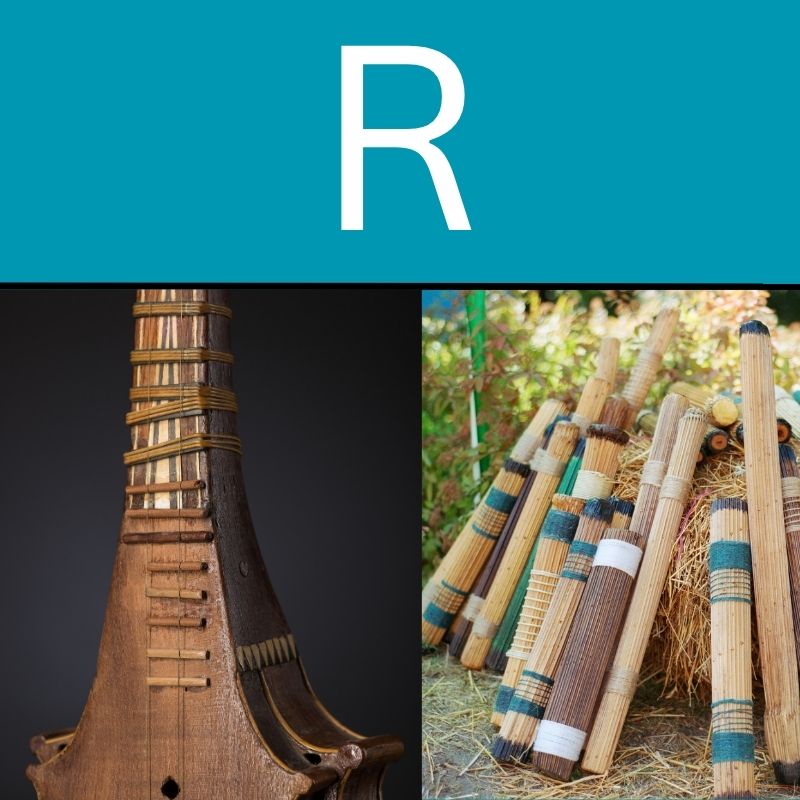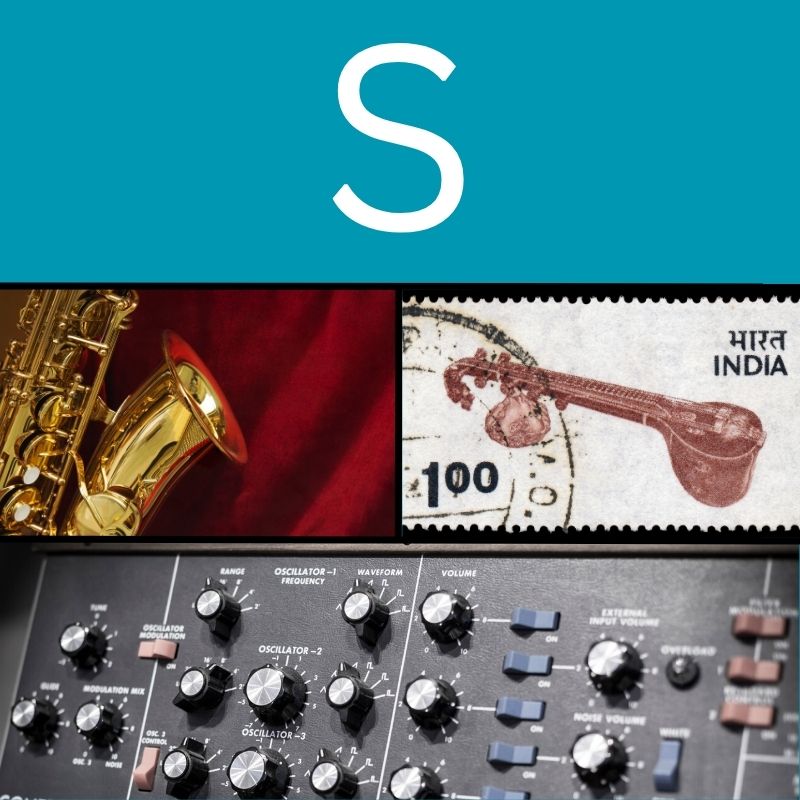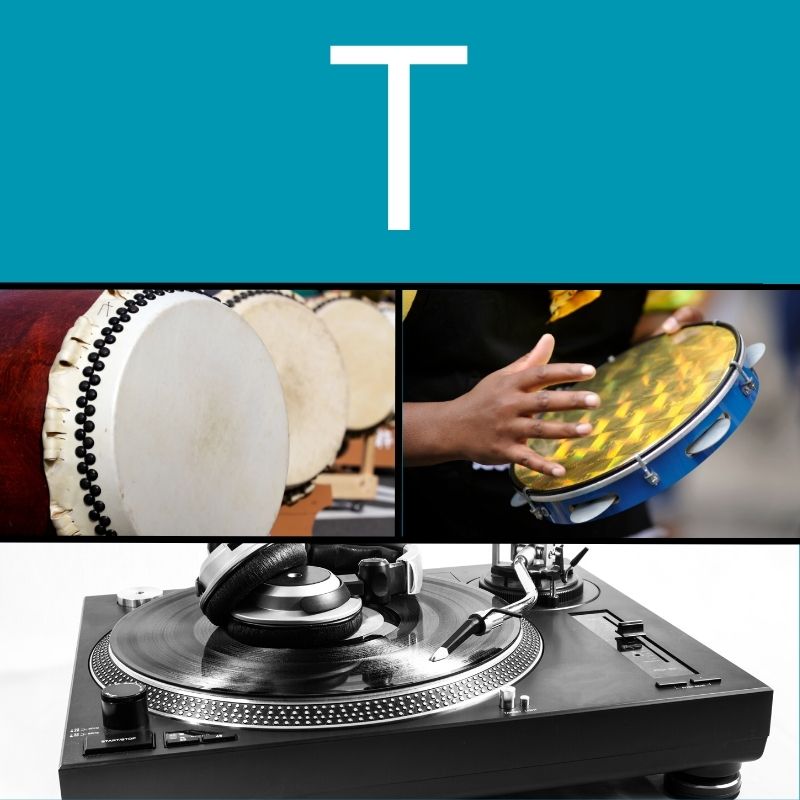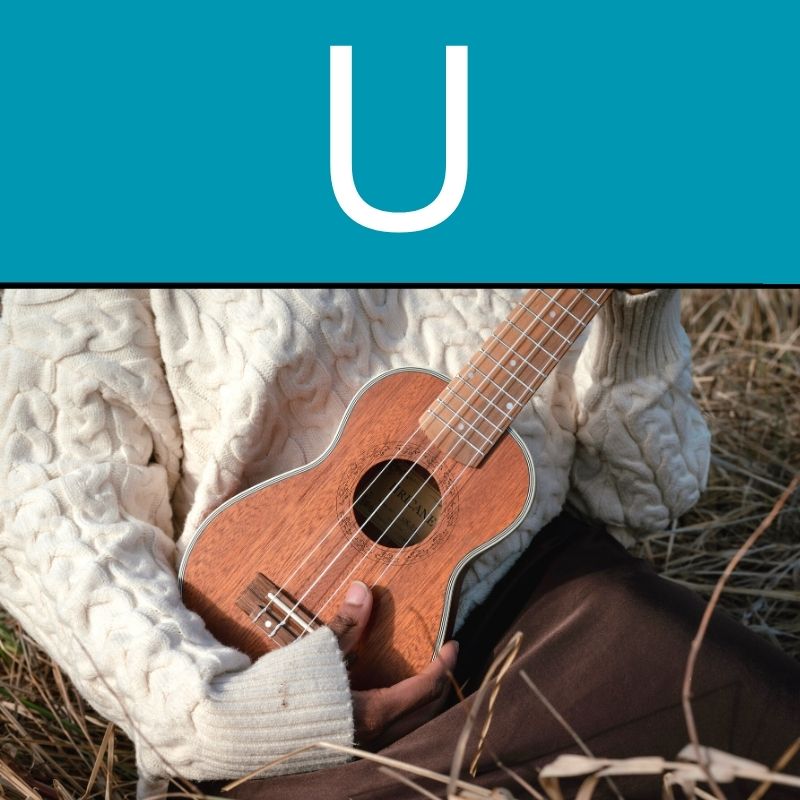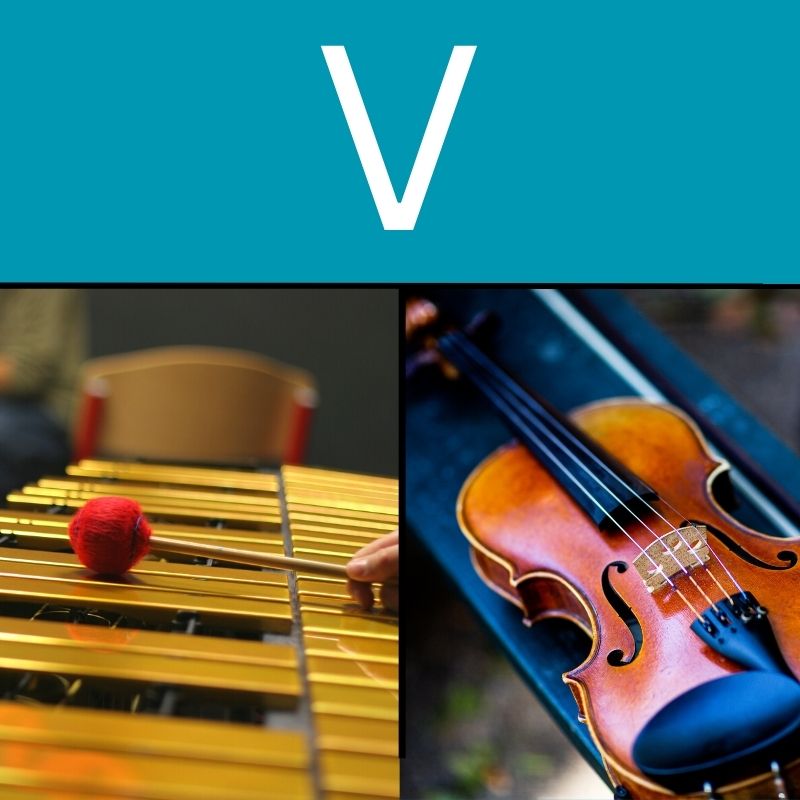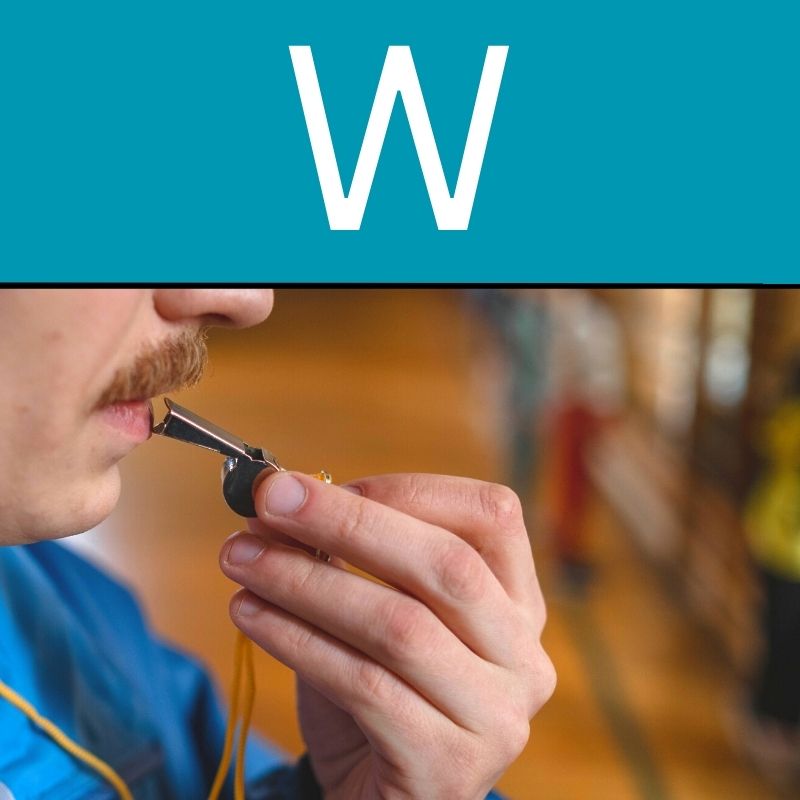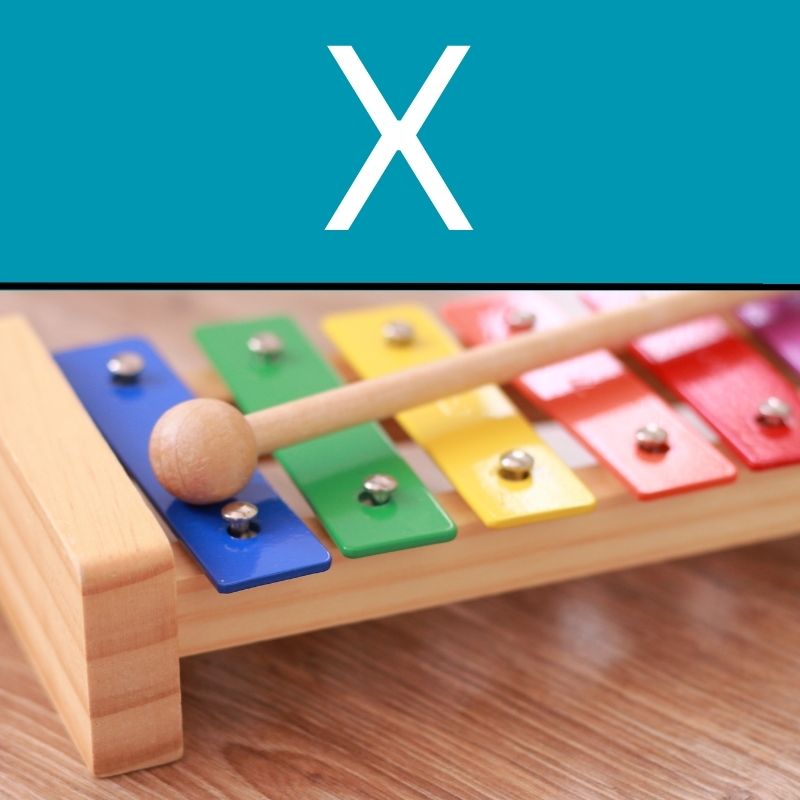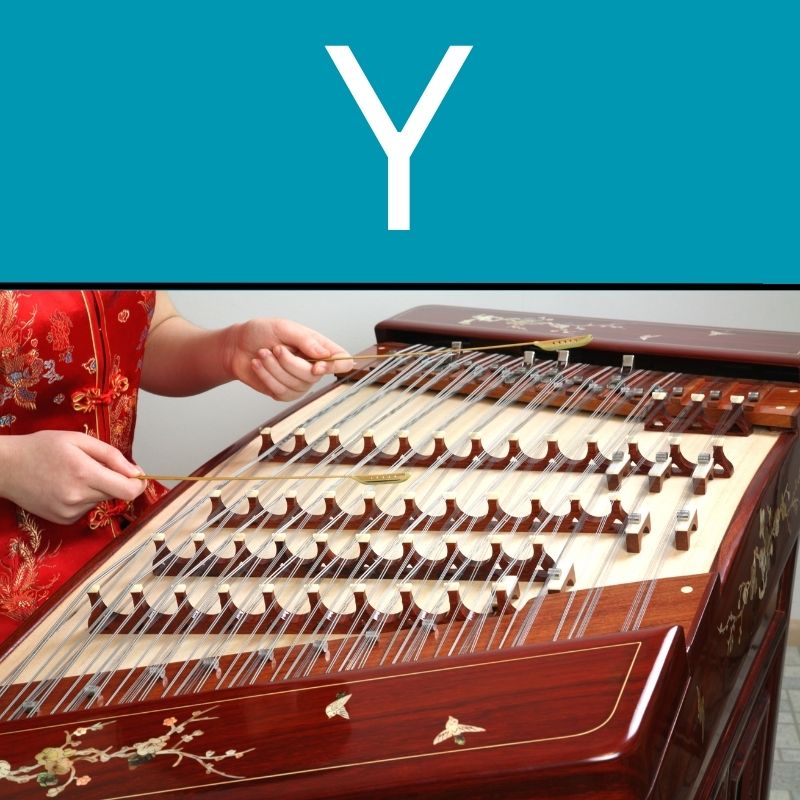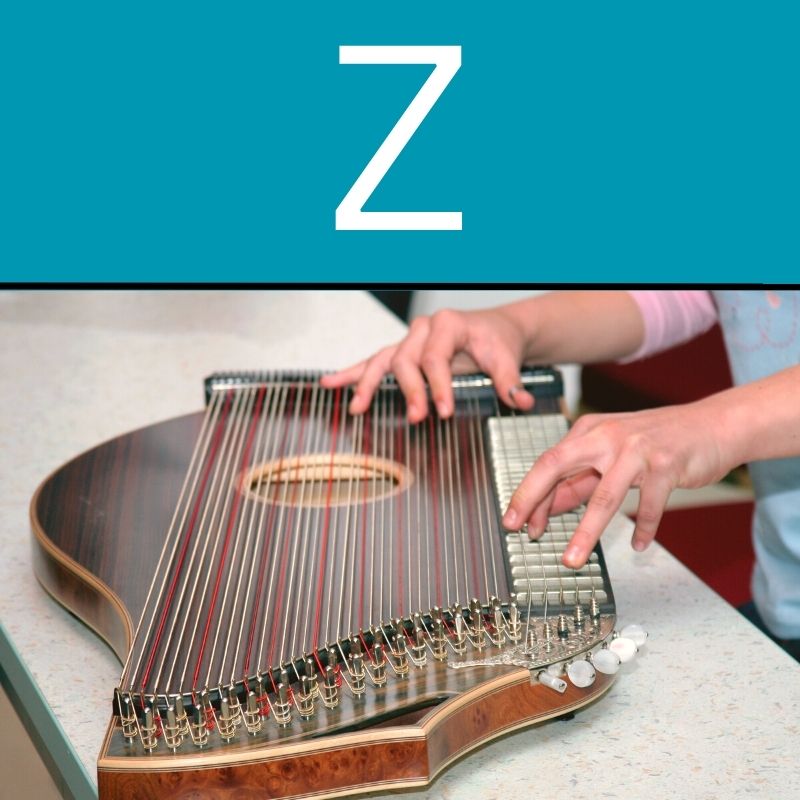Music plays a central part in every global culture. Even the earliest societies found ways to make instruments.
In fact, the oldest musical instrument ever found dates back 60,000 years and is known as the Neanderthal Flute! It was discovered in a cave in Slovenia and is made of a bear’s bone.
Since then, instruments have come a long way, and different regions of the world have developed unique musical traditions.
One of the first things many of us think of when we picture the different areas around the world is what the music sounds like there.
And what gives countries such distinct musical tones and harmonies? There’s more to it than song-writing and composing styles.
In fact, a huge part of what makes local musical traditions so special are their unique instruments. And so many of us don’t even know half the instruments used around the globe!
How many musical instruments can you name? Ten or twenty?
If you want to increase your knowledge about musical instruments, check out this comprehensive overview of the instruments used around the world over the centuries (and learn how to refer to them in a sentence).
Also, if you would like to download a list with musical instruments from A to Z as a PDF, you will find a download link at the very end of this post.
Musical Instruments in Alphabetical Order (from A to Z)
- Accordion
- Acoustic guitar
- Aeolian harp
- Agogo bells
- Alto clarinet
- Alto flute
- Alto saxophone, Anvil
- Appalachian dulcimer
- Archlute
- Archtop guitar
- Aulos
- Autoharp
- Aztec death whistle
- Bagpipes
- Banjo
- Bass clarinet
- Bass drum
- Bass guitar
- Bassoon
- Bell lyre
- Berimbau
- Bongo drum
- Bouzouki
- Bugle
- Bullroarer
- Byzantine lyra
- Castanets
- Celesta
- Cello
- Chapman stick
- Charango
- Chimes
- Chinese lute
- Church organ
- Clap sticks
- Clarinet
- Clavichord
- Clavinet
- Concertina
- Conga drum
- Cor anglais
- Cornet
- Cowbell
- Crash cymbal
- Crotales
- Cuatro
- Cymbal
- Darbuka
- Didgeridoo
- Digital piano
- Djembe
- Dobro
- Double bass
- Drum kit
- Dulcimer
- Electric guitar
- Electric piano
- Electronic drums
- English horn
- Erhu
- Euphonium
- Fiddle
- Finger cymbals
- Flugelhorn
- Flute
- French horn
- Fujara
- Gamelan
- Ghatam
- Glockenspiel
- Gong
- Gopichand
- Grand piano
- Great Highland bagpipes
- Guitar
- Hammered dulcimer
- Handpan
- Harmonica,
- Harp
- Harpsichord
- Highland bagpipes
- Igil
- Indian harmonium
- Irish bouzouki
- Irish flute
- Irish harp
- Jaw harp
- Jug
- Kalimba
- Kaval
- Keyboard
- Kora
- Koto
- Kudu horn
- Lap steel guitar
- Lute
- Lyre
- Mandolin
- Maracas
- Marimba
- Mbira
- Mellophone
- Mellotron
- Microphone
- Mridangam
- Nagara
- Ney
- Nyckelharpa
- Oboe
- Octobass
- Ondes Martenot
- Orchestral bells
- Organ
- Oud
- Pandeiro
- Pan flute
- Pedal steel guitar
- Piano
- Piccolo
- Pipe organ
- Pipa
- Plainsong
- Quena
- Rabab
- Rainstick
- Recorder
- Requinto
- Resonator guitar
- Riq
- Sackbut
- Samba whistle
- Sanxian
- Saxophone
- Shakuhachi
- Shamisen
- Shehnai
- Sitar
- Slide whistle
- Snare drum
- Soprano saxophone
- Sousaphone
- Steel drum
- Steel string accoustic guitar
- Steelpan
- String bass
- Synthesizer
- Tabla
- Taiko drum
- Tambora
- Tambourine
- Tenor saxophone
- Theremin
- Timbales
- Timpani
- Tin whistle
- Tiple, Tuba
- Turntable
- Ukulele
- Upright bass
- Veena
- Vibraphone
- Vielle
- Viola
- Viol
- Violin
- Virginal
- Waldzither
- Washboard
- Waterphone
- Whistle
- Wind chimes
- Wood block
- Xaphoon
- Xylophone
- Yangqin
- Zampogna
- Zarb
- Zither
Musical Instruments that start with A
Accordion, acoustic guitar, aeolian harp, agogo bells, alto clarinet, alto flute, alto saxophone, anvil, Appalachian dulcimer, archlute, archtop guitar, aulos, autoharp, Aztec death whistle.
Some of the most interesting musical instruments beginning with “A” are the accordion, the autoharp, and the Appalachian dulcimer.
The accordion is a bellow-driven, box-shaped instrument that is frequently used in European and American folk music.
Accordionists use these “squeezeboxes” by playing the melody with the buttons on the right-hand side and compressing and expanding the folding bellows in the center of the instrument.
The Autoharp is a staple of North American folk music.
Also known as the chord zither, the instrument was first patented by Charles F. Zimmerman, a German immigrant living in Philadelphia.
The instrument is made up of a rectangular soundboard with one cut-off corner. The strings are connected to chord bars, which resemble a miniature piano.
The Appalachian dulcimer looks like a long, thin guitar. This zither instrument usually has four strings and originated in the Appalachian Mountains.
The first known dulcimers were crafted by Irish and Scottish newcomers to the US in the 18th century.
One of the most famous dulcimer players was Loraine Wyman, who was pictured holding her instrument in the May 1917 issue of US Vogue.
Example: How to use “accordion” in a sentence
Example: How to use “autoharp” in a sentence
Example: How to use “Appalachian dulcimer” in a sentence
Musical Instruments that start with B
Bagpipes, banjo, bass clarinet, bass drum, bass guitar, bassoon, bell lyre, berimbau, bongo drum, bouzouki, bugle, bullroarer, byzantine lyra.
Some of the most fascinating instruments that start with the letter “B” include the bagpipes, the bass guitar, and the bullroarer.
Most of us associate bagpipes, which consist of an air bag, a melody pipe (chanter), and multiple drones, with Scotland.
However, they are also used in parts of Asia and in the Persian Gulf. Historians believe that bagpipes originated in Anatolia in 1000 BCE.
The bass guitar is a staple of the rock genre. This low-pitched instrument requires an amp to make its deep tones heard.
Bullroarers are traditional musical instruments used by Australian Aboriginal people.
Used in ritual ceremonies and to communicate between groups over vast distances, these wood pieces were tied on strings and swung around rapidly to create a loud whirring sound.
Example: How to use “bagpipes” in a sentence
Example: How to use “bass guitar” in a sentence
Example: How to use “bullroarer” in a sentence
Musical Instruments that start with C
Castanets, celesta, cello, chapman stick, charango, chimes, Chinese lute, church organ, clap sticks, clarinet, clavichord, clavinet, concertina, conga drum, cor anglais, cornet, cowbell, crash cymbal, crotales, cuatro, cymbal.
What are the most exciting instruments that begin with the letter “C”? The cello, cowbell, and chimes are certainly strong contenders.
A musical instrument is a device that has been made or adapted to create musical sounds.
This is such a broad definition that it is sometimes hard to remember what all these diverse devices have in common.
Looking at the variety of instruments that begin with “C” is a great illustration of this.
For example, a cello is a classical string instrument made by master craftspeople.
A professional-level cello typically costs over $10,000. A cowbell (a metal, bell-shaped instrument played with a mallet) can cost as little as $10.
Then there are wind chimes, which are typically hung outside on porches and played by the wind…which begs the question, does an instrument have to be played by a person to be an instrument?
Example: How to use “chimes” in a sentence
Example: How to use “cello” in a sentence
Example: How to use “cowbell” in a sentence
Musical Instruments that start with D
Darbuka, didgeridoo, digital piano, djembe, dobro, double bass, drum kit, dulcimer.
Some of the most fascinating musical instruments beginning with “D” that you’ve probably never heard of are the darbuka, the digeridoo, and the dobro.
The darbuka is a unique middle eastern drum.
This iconic percussion instrument hails all the way back to ancient Egyptian and Sumerian times. Darbukas are easily identifiable by their classic goblet shape.
The didgeridoo is a wooden instrument that has been being played by members of the Australian Aboriginal community for over 40,000 years.
Didgeridoos are made from hollowed out fallen branches of eucalyptus trees and make a droning sound.
Dobro is a brand of American resonator guitars. Known as “Dobros,” these vintage-style six-strings are wood cones that feature a single-cone resonator.
Dobro is now owned by Gibson, which is known for creating top-of-the-line country acoustic guitars.
Example: How to use “darbuka” in a sentence
Example: How to use “didgeridoo” in a sentence
Example: How to use “dobro” in a sentence
Musical Instruments that start with E
Electric guitar, electric piano, electronic drums, English horn, erhu, euphonium.
Looking for unique instruments that begin with “E”? Look no further. Let’s learn about the electronic drums, the erhu, and the euphonium!
Electronic drumkits are an alternative to traditional acoustic drumkits.
They include an electronic sound module that produces synthesized drum and symbol noises.
Drummers hit so-called “pads” with their drumsticks, and electronic sensors cause the module to play the desired sounds.
Erhus are beautiful Chinese bowed instruments.
These proto-Mongolic instruments have only two strings and are often played in small orchestras.
They have a violin-like appearance and date all the way back to the Tang dynasty.
Euphoniums are brass instruments with piston-valves that emit a sweet, melodic sound, not unlike a French horn.
Example: How to use “electronic drum” in a sentence
Example: How to use “erhu” in a sentence
Example: How to use “euphonium” in a sentence
Musical Instruments that start with F
Fiddle, finger cymbals, flugelhorn, flute, French horn, fujara
Among the most difficult instruments to play that begin with “F” are the flute, the flugelhorn, and the fujara.
The flute is a metal wind instrument with a curved mouthpiece and padded keys.
You have to use the angle of your mouth and force of your breath to keep it in tune. Fun fact: flute players are called flautists!
The flugelhorn looks a lot like a trumpet. In fact, many people who aren’t familiar with the brass family might mistake the two!
However, the flugelhorn is actually more like a bugle, the instrument traditionally used in hunting.
The fujara is a wooden wind instrument with its roots in the shepherding population of central Slovakia.
It ranges between 5 and 7 feet long and has three holes, which players use to create different sounds.
Example: How to use “flute” in a sentence
Example: How to use “flugelhorn” in a sentence
Example: How to use “fujara” in a sentence
Musical Instruments that start with G
Gamelan, ghatam, glockenspiel, gong, gopichand, grand piano, great Highland bagpipes, guitar.
Of all the instruments that begin with the letter “G,” three stand out as emblems of traditional culture.
These are the ghatam, the gong, and the gopichand.
The ghatam is an Indian percussion instrument that resembles a large clay vase and is sometimes adorned with copper or brass.
It has its origins in Tamil and Punjabi cultures, and its name comes from the Sanskrit word ghataka, which means pot.
A gong is a percussion instrument that originated in Southeast and East Asia.
Gongs look like round, flat metal discs and are hit with padded mallets or sticks.
They have sacred importance and are often used in religious temples or monasteries.
A Gopichand is a single-string Indian instrument.
The string is held between a pot-like base and a tuning peg, which is elevated and held in place by two parallel pieces of wood. The string can be tuned to different pitches.
Example: How to use “ghatam” in a sentence
Example: How to use “gong” in a sentence
Example: How to use “gopichand” in a sentence
Musical Instruments that start with H
Hammered dulcimer, handpan, harmonica, harp, harpsichord, highland bagpipes.
The easiest instruments to play that begin with the letter “H” are probably the handpan and the harmonica.
The handpan is essentially two rounded metal halves that have been fastened together.
On the handpan’s surface are seven different notes or “tone fields,” which can be hit to make different sounds and played in various combinations to create melodies.
It is a relatively new invention and only emerged in 2007. It is a variation on the steelpan, an older, more established percussion instrument.
If you’re interested in steel instruments, make sure you check out the handpan’s older relative.
The harmonica is a staple of American folk-rock, but it has its origins thousands of years back, in Asia.
However, it’s more recent ancestor, the German “mouth organ” (Mundorgan) only arrived on the scene in the 1800s.
Example: How to use “handpan” in a sentence
Example: How to use “harmonica” in a sentence
Musical Instruments that start with I
Igil, Indian harmonium, Irish bouzouki, Irish flute, Irish harp.
If you’re looking for a bit of Gaelic musical influence, you need look no further than musical instruments that begin with “I.”
Among the instruments that begin with the word “Irish,” are the Irish bouzouki, the Irish flute, and the Irish harp.
The Irish bouzouki is a variation of the Greek bouzouki.
This six-string wooden instrument that looks like something between a guitar and a banjo was brought to the green island in the mid-20th century.
The Irish flute has been on Irish soil for much longer.
This wooden flute has none of the delicate silver keys of the classical flute.
Gaelic chieftains had harpists whom they could call to play for them at will. Irish harpists were valued so highly that Brehon law placed harsh penalties on anyone who damaged these musicians’ fingers or nails.
Example: How to use “Irish bouzouki” in a sentence
Example: How to use “Irish flute” in a sentence
Example: How to use “Irish harp” in a sentence
Musical Instruments that start with J
Jaw harp, jug.
Surprisingly, there aren’t actually that many instruments that begin with the letter “J.” But that doesn’t mean we should discount the ones that do!
The jaw harp and the jug are both play fantastic tunes and are well worth writing about.
The jaw harp is an unusual-looking musical device that originated in Siberia.
It consists of a metal frame shaped like a pear that is about the size of a person’s tongue.
The frame holds a reed in place, which vibrates when the player puts the instrument between their teeth and plucks at the reed.
The jug is literally that: A jug. Musicians play the jug by holding it just below their mouth and “buzzing” their lips to create a vibrating sound. Jugs originated in the USA in the 1920s.
Example: How to use “jaw harp” in a sentence
Example: How to use “jug” in a sentence
Musical Instruments that start with K
Kalimba, kaval, keyboard, kora, koto, kudu horn.
Some of the most surprising instruments that begin with “K” include the kalimba, the kaval, and the kudu horn.
The kalimba is a miniature thumb piano that originated in Africa. There are 19- and 15-key versions.
Essentially, kalimbas look like wooden boxes with a hole cut out in their center.
Above the hole are a series of metal keys that musicians press down with their thumbs.
The kaval is an end-blown flute, which means that unlike the Irish flute and the classical flute, it is held vertically and not horizontally.
It is traditionally from the Balkan region, where it was played by shepherds.
The kudu horn is an instrument made from the horn of the African kudu.
The kudu is a beautiful animal with white stripes like a zebra, twisted horns like a ram, and a hackled back like a hyena.
Example: How to use “kalimba” in a sentence
Example: How to use “kaval” in a sentence
Example: How to use “kudu horn” in a sentence
Musical Instruments that start with L
Lap steel string acoustic guitar, lute, lyre.
Can you think of some of the best country music instruments that begin with “L”? You can’t go wrong with the lap steel string acoustic guitar, the lute, and the lyre.
The lap steel string acoustic guitar has kind of a misleading name.
While it is certainly a guitar, it isn’t the kind you hold up and strum. Instead, this steel-stringed marvel gets placed across the musician’s lap, where they pluck at it with a pick.
The lute is a plucked string instrument with a long neck and a deep, rounded back section.
This rounding creates a large space for the acoustic sounds of the instrument’s strings to reverberate.
Many people consider the lyre the original folk instrument.
Its curved wooden frame that spans taught strings was popular in ancient Greece. The lyre was played as early as 2700 BCE in Mesopotamia.
Example: How to use “lap steel string acoustic guitar” in a sentence
Example: How to use “lute” in a sentence
Example: How to use “lyre” in a sentence
Musical Instruments that start with M
Mandolin, maracas, marimba, mbira, mellophone, mellotron, mridangam.
Do you have a favorite instrument that begins with the letter “M”? If not, you’ll have to at least consider choosing the mandolin, the marimba, and the mridangam.
The mandolin is a close relation of the lute. This stringed, round-bodied instrument is a bluegrass icon.
It has four courses of double strings and gets played with a standard pick.
The marimba is technically a percussion instrument, but don’t let that fool you into thinking it is small or doesn’t take serious skill to play.
This traditional bantu instrument has the appearance of a large wooden xylophone, and it gets played with mallets.
The mridangam is considered a holy instrument in India, and deities are often shown holding this ancient percussion instrument that looks like a cylinder of hollow wood. Modern mridangams are carved from jackfruit wood.
Example: How to use “mandolin” in a sentence
Example: How to use “marimba” in a sentence
Example: How to use “mridangam” in a sentence
Musical Instruments that start with N
Nagara, ney, nyckelharpa.
I’ll wager you’ve never come across these three exciting instruments that begin with the letter “N.”
Have you ever heard of the nagara, the ney, or the nyckelharpa? If you haven’t, you’re about to!
The nagara is a middle eastern drum with a round top that is played at traditional formal occasions and festivals.
The ney is a flute of Persian origin that dates back at least 5,000 years.
Much like a recorder, it is an end-blown wooden tube with holes cut out of its body.
The nyckelharpa is a keyed fiddle. It looks like a violin with a set of keys coming off its right-hand side.
The earliest depiction of this versatile folk instrument was found in Gotland, Sweden and dates back to 1350.
Example: How to use “nagara” in a sentence
The circle of drummers was playing their nagaras, and the rhythmic beating could be heard for miles.
Example: How to use “ney” in a sentence
Example: How to use “nyckelharpa” in a sentence
Musical Instruments that start with O
Oboe, octobass, ondes martenot, orchestral bells, organ.
Do you know which classical instruments begin with the letter “O”?
There is no shortage of them, but some of the most well-known include the oboe, the octobass, and the organ.
The oboe is a reeded woodwind instrument with a black body and a complex system of silver keys.
It is held out in front of the player like a recorder. Oboe players have to make their own reeds, which they change often.
Have you ever seen a double bass? Well, an octobass looks very similar, except that it is a lot bigger.
Octobasses are stand-up stringed instruments that can be up to 3.5 meters tall.
Organs are played using a keyboard. However, unlike pianos, their keys are attached to pipe divisions, which project their sound widely. In addition to church organs, there are also pump, electronic, and mechanical organs.
Example: How to use “oboe” in a sentence
Example: How to use “octobass” in a sentence
Example: How to use “organ” in a sentence
Musical Instruments that start with P
Pandeiro, pan flute, pedal steel guitar, piano, piccolo, pipe organ, pipa, plainsong.
Some of the most niche musical instruments you’ve never heard of begin with the letter “P.”
These include the pandeiro, the pipa, and the plainsong.
The pandeiro is a Brazilian hand-frame drum that looks like a tambourine.
In addition to hitting its edges lightly to produce a rhythm, you can also shake it, so that the silver jingles in its side shake, creating a metallic jangling sound.
The pipa is a pear-shaped Chinese string instrument that originated around 2,000 years ago.
It is not unlike the European lute and features four strings and a long neck.
The plainsong isn’t technically an instrument.
However, for all intents and purposes, modern musical theorists treat it like one.
Plainsong is a series of Latin chants used by members of the western, catholic church.
Example: How to use “pandeiro” in a sentence
Example: How to use “pipa” in a sentence
Example: How to use “plainsong” in a sentence
Musical Instruments that start with Q
Quena.
Ah, “Q.” It’s one of the least popular letters in Scrabble for a reason. And that reason is that there just aren’t that many words that begin with Q.
And that’s no different when it comes to the names of musical instruments.
However, there is one fascinating instrument that begins with the letter “Q” called the quena, and it’s certainly worth learning about.
The quena is a flute that originated in the Andes mountains of South America.
It only has six finger holes, which is even fewer than a modern recorder.
The quena is made of hollow cane or wood.
Unlike the recorder, its end is just an open hole, which must be pressed into the player’s chin, just below their lower lip to block air flow.
Then, the musician can blow across a u-shaped hole cut into the open end of the Quena.
Example: How to use “quena” in a sentence
Musical Instruments that start with R
Rabab, rainstick, recorder, requinto guitar, resonator guitar, riq.
There is a wide variety of musical instruments that begin with “R.”
Some of the most unusual instruments that start with “R” are the rabab, the requinto, and the riq.
The rabab isn’t all too different from a lute. It has been used across Asia and the Middle East for centuries, and each country or region has its own variety.
This means it is important to check which kind of rabab you are looking for if you decide to invest in one.
The requinto guitar is essentially a smaller version of a standard guitar.
It has a slightly higher pitch than its classical counterpart.
It features in a lot of Ecuadorian music but is also often used in Mexico and other Central and South American countries.
The riq is a middle eastern tambourine with 10 pairs of jingles.
It is often adorned with beautiful engravings between its five jingle stacks of two double-jingles.
Example: How to use “rabab” in a sentence
Example: How to “requinto” in a sentence
Example: How to “riq” in a sentence
Musical Instruments that start with S
Sackbut, samba whistle, sanxian, saxophone, shakuhachi, shamisen, shehnai, sitar, slide whistle, snare drum, soprano saxophone, sousaphone, steel drum, steel guitar, steelpan, string bass, stringed instrument, synthesizer.
Not many people know this, but “S” is the letter that begins the most words in the English language.
A whopping “10.6%” of words in English begin with “S.” And instrument names are no exception.
Some of the most interesting “S” instruments include the sackbut, the sousaphone, and the shakuhachi.
The sackbut is an old-fashioned version of the trombone.
It hails from the time of Baroque music and is smaller than its modern-day counterpart.
The sousaphone is an impressive brass instrument with a large horn that reaches up above the player’s shoulder.
It is used in marching bands and was designed by John Philip Sousa as a variation on the tuba that would be easier to walk with.
The shakuhachi is Japanese wooden flute that is traditionally created using bamboo.
It hails from the 16th century and was originally used during Zen meditation sessions.
Example: How to use “sackbut” in a sentence
Example: How to use “sousaphone” in a sentence
Example: How to use “shakuhachi” in a sentence
Musical Instruments that start with T
Tabla, taiko drum, tambora, tambourine, tenor saxophone, theremin, timbales, timpani, tin whistle, tiple, tuba, turntables.
There are instruments from all around the world that begin with the letter “T.” Three instruments that begin with “T” that have great fun facts about them are the taiko drum, the theremin, and the tin whistle.
The first record of a taiko drum in Japan is from the 6th century.
A fun fact about the taiko drum is that they were used during the 16th-century warring states period. Drumbeat sequences were used to communicate messages between troops.
The theremin is an electronic instrument. A fun fact about this device invented in 1928 is that it can be played without being touched.
The player simply moves their hands around in front of the antennae and the device responds by making different sounds.
Looking for a fun fact about the tin whistle?
There are musical historians who believe the earliest related whistle may date back to before 80,000 BCE!
Example: How to use “taiko drum” in a sentence
Example: How to use “theremin” in a sentence
Example: How to use “tin whistle” in a sentence
Musical Instruments that start with U
Ukulele, upright bass.
Want to know something funny about instruments that begin with the letter “U”?
The the two most popular instruments that begin with “U,” the ukulele and the upright bass, are respectively considered the smallest and largest common string instruments there are.
The ukulele is like a tiny four-string guitar. This instrument is often associated with Hawaii (it means “jumping flea” in Hawaiian) but was probably brought there by Portuguese visitors in the late 19th century.
The upright bass, also known as the double bass, is a classical string instrument that is usually the largest part of a symphony orchestras.
Example: How to use “ukulele” in a sentence
Example: How to use “upright bass” in a sentence
Musical Instruments with V
Vibraphone, veena, vielle, viola, viol, violin, virginal.
“V” is for variety, right? Well, there is certainly no shortage of string instruments that begin with “V.”
Some of the most popular instruments that start with “V” are the viola, the viol, and the violin.
The viola looks a lot like a larger version of the violin. It is considered the alto of string instruments.
The viol is a string instrument with a hollow body. Viols look a lot like members of the violin family, but they have flat backs, and c holes instead of f holes.
They also have more strings than violins: Viols have between five and seven, whereas members of the violin family have four.
The violin is a wooden string instrument that plays an integral role in western classical music.
It typically has four strings and is the backbone of the modern symphony orchestra, which features two violin sections.
Example: How to use “viola” in a sentence
Example: How to use “viol” in a sentence
Example: How to use “violin” in a sentence
Musical Instruments with W:
Waldzither, washboard, waterphone, whistle, wind chimes, wood block.
Can you think of instruments with unusual names that start with “W”? Well, here are three: The washboard, the waterphone, and the wood block.
The washboard is literally a washboard. As in, people play French-style washboards that have ribbed metal lines on them as percussion instruments.
The ridges people once used to get dirt out of their clothes are now used to create beats.
The waterphone (or ocean harp) is an acoustic instrument comprised of a bowl that has water in it and a series of bronze rods that stretch up from the edge of the bowl. It is played using one’s hands or a mallet.
The wood block is also literally just what it sounds like.
These wooden rectangular instruments are hollowed out and make a resounding sound when hit with a mallet.
Example: How to use “washboard” in a sentence
Example: How to use “waterphone” in a sentence
Example: How to use “wood block” in a sentence
Musical Instruments with X:
Xaphoon, xylophone.
When it comes to instruments that begin with “X,” we always think of xylophone.
However, it isn’t the only one. Another fascinating instrument that begins with “X” is the xaphoon.
A xylophone is a percussion instrument with wooden or metal bars that gets played when a musician strikes the bars with mallets.
A xylophone can be anything from a children’s metal glockenspiel to a full-fledged orchestral, chromatic percussion instrument, which costs around $30,000.
A xaphoon is essentially a single-reed clarinet. Traditionally made of bamboo, these instruments, which are also known as Hawaiian saxophones, look like recorders.
Brian Wittman, the xaphoon’s creator, still makes these instruments at his home on Maui.
Example: How to use “xylophone” in a sentence
Example: How to use “xaphoon” in a sentence
Musical Instruments with Y:
Yangqin
There is only one instrument that begins with “Y” that is really worth mentioning, and that is the yangqin.
This incredible contraption can only be played by a skilled, trained musician.
This dulcimer is shaped like a trapezoid and has steel alloy strings.
Modern instruments can have up to five courses of bridges. Yanqin players use bamboo beaters with rubber tips to tap the strings of their instrument.
The Yangqin originated in China, but variations of it are now used all over Asia and the Middle East.
Example: How to use “yanqin” in a sentence
Musical Instruments with Z:
Zampogna, Zarb, Zither.
Do you know what the most beautiful instruments that begin with the letter “Z” are?
Let’s start by examining the zampogna, the zarb, and the zither.
The zampogna is an Italian variety of bagpipes. It has two chanters (usually a soprano one and a bass one) and is still used by folk bands throughout the country.
The zarb, which is often referred to as a tombak, is a goblet drum with its origins in Iran.
It is considered the most important percussion instrument in the region and its unique sound forms an integral part of traditional Persian music.
The zither is a flat-bodied, wooden stringed instrument.
Zithers are played lying flat. Musicians strum or pluck their strings, which are strung across a cut-out hole in the wood.
Zithers have a sound that is somewhere between a guitar and a harpsichord.
Example: How to use “zampogna” in a sentence
Example: How to use “zarb” in a sentence
Example: How to use “zither” in a sentence
Musical Instrument Types
There are five main kinds of music instruments: percussion, woodwinds, brass, keyboards, and strings.
Many musical collectives include several of these different instrument types.
An orchestra, for example, contains all the categories except keyboards (and occasionally brass), while a marching band includes woodwinds, brass, and percussion.
When it comes to linguistics, you can generally use similar words to describe playing instruments from the same musical family.
For example, you blow into a flute, clarinet, or saxophone; press down on the keys of a keyboard instrument; and bow, pluck or strum string instruments.
Instruments of one type also tend to be made up of similar components.
For example, string instruments all have strings and tuning keys, and many have bridges and are played with bows. Wind instruments, on the other hand, typically have mouthpieces or reeds, and either finger holes or keys, or some combination of the two.
For a detailed overview of each type of musical instrument and a list of the most popular instruments in that category, read on!
Percussion Instruments
- Bells
- Cymbals
- Drums
- Gongs
- Timpani
- Xylophone
Percussion instruments are basically anything that makes a noise when hit, rubbed, scraped, or shaken.
Percussionists are usually responsible for creating the beat or background sounds for the instruments that play the melody.
That said, there are exceptions to this rule: Just think about the xylophone!
The percussion family is responsible for the rhythm of the music, and for adding a bit of extra flair.
Orchestras all have percussion sections, and the instruments they contain will depend on the piece the orchestra is playing.
However, there is typically always a Timpani set (big, kettle-like drums), cymbals, and a xylophone.
In most popular music, the main percussionist is the drummer. Just think about all the legendary rock’n’roll drummers who are wizzes at the modern drum kit!
Woodwind Instruments
- Bassoon
- Clarinet
- Flute
- Oboe
- Recorder
- Saxophone
If you are wondering why woodwind instruments are called woodwinds when they clearly aren’t all made of wood, you’re not alone!
The reason woodwinds have their name is because all of them were traditionally made of wood.
However, now that the materials available to craftspeople have increased, many of these instruments are now also made with metal and plastic.
What woodwinds have in common is that they are have cylindrical shapes, an opening for the mouth and at the bottom of the instrument, and holes along their bodies.
They are played by musicians who use their breath (or wind) to blow air into the cylinder, which produces a sound.
There are two main differences between most varieties of woodwinds.
The first has to do with the style of the mouthpiece. Woodwinds either have an open mouthpiece or a reeded mouthpiece.
Recorders and flutes have open mouthpieces, for example, whereas bassoons and oboes use reeds.
The second difference has to do with whether the instruments’ keys are covered or not.
Recorders have holes along their bodies that get covered by players fingers.
Most classical woodwinds, however, either have keypads that are pressed down against their holes to close them, or else some combination of keypads and holes.
Brass Instruments
- Baritone horn
- Cornet
- Euphonium
- Flugelhorn
- French horn
- Horn
- Mellophone
- Sousaphone
- Tenor horn
- Trombone
- Trumpet
- Tuba
The brass family includes a wide range of horn-like instruments that widen at their ends in a bell shape.
This category of instruments is called the “brass” family because they are all made of brass. Makes sense, right?
You can think of brass instruments as long brass horns that have been curved into different shapes to make them easier to play.
There are two main kinds of brass instruments: valved brass instruments and slide brass instruments.
Valved instruments have valves that look like buttons, which are pressed to create different notes.
Slide instruments like the trombone are played by pushing and pulling a sliding element, which changes the pitch by changing the length of the pipe.
Like woodwind players, brass players must use their own breath to play their instrument.
Brass instruments have a curve metal mouthpiece that is played by pressing against it with pursed lips and making a buzzing sound.
This vibration goes into the instrument and creates that telltale brassy, trumpeting sound.
Keyboard Instruments
- Harpsichord
- Organ
- Piano
The most famous keyboard instrument is of course the piano. But the piano is not the only instrument worth learning about.
The organ and harpsichord are also valuable keyboard instruments to know about.
Keyboard instruments are characterized by a row of levers that players press down on with their fingers.
These levers are called keys, and because they are organized in a straight line across a board, the instruments they are part of are referred to as having keyboards.
Pianos, harpsichords, and organs all have keys that correspond to notes on the chromatic scale.
One of the main advantages that keyboard instruments have over any of the other categories is that you can play more than one note at once.
This allows pianists and organ players to play chords and melodies at the same time.
A keyboard device is the basically the only kind of musical instrument that can harmonize with itself!
Here is a list of the most common kinds of keyboard instruments:
String Instruments
- Double Bass
- Cello
- Electric Guitar
- Erhu
- Fiddle
- Guitar
- Harp
- Kora
- Lute
- Mandolin
- Oud
- Sitar
- Shamisen
- Steel string acoustic guitar
- Viola
- Violin
String instruments include any instrument that has strings.
The instruments in the string family are generally made of wood, which has been crafted into a specific shape and is hollow.
The wooden body of a string instrument usually has holes that have been cut into it.
The strings have been pulled tight across these holes.
The strings are held tight by tuning pegs or keys, which can be twisted to adjust the tightness of the string and thereby to alter their pitch.
Some string instruments, typically those that belong to the western classical tradition, have bridges, which elevate the strings up higher above the body of the instrument.
These instruments also tend to have bows made of taught, fine hair, which are pulled and pushed over the strings.
Other string instruments, such as guitars, sitars, and lutes, are played by being strummed or plucked and do not have bridges.
The string family makes up the largest section of a symphony orchestra, which includes violins, violas, cellos, and the double bass.
List with Musical Instruments from A to Z Download (PDF)
If you would like to download a list with the most popular instruments from A to Z, here you go:

Hey fellow Linguaholics! It’s me, Marcel. I am the proud owner of linguaholic.com. Languages have always been my passion and I have studied Linguistics, Computational Linguistics and Sinology at the University of Zurich. It is my utmost pleasure to share with all of you guys what I know about languages and linguistics in general.

